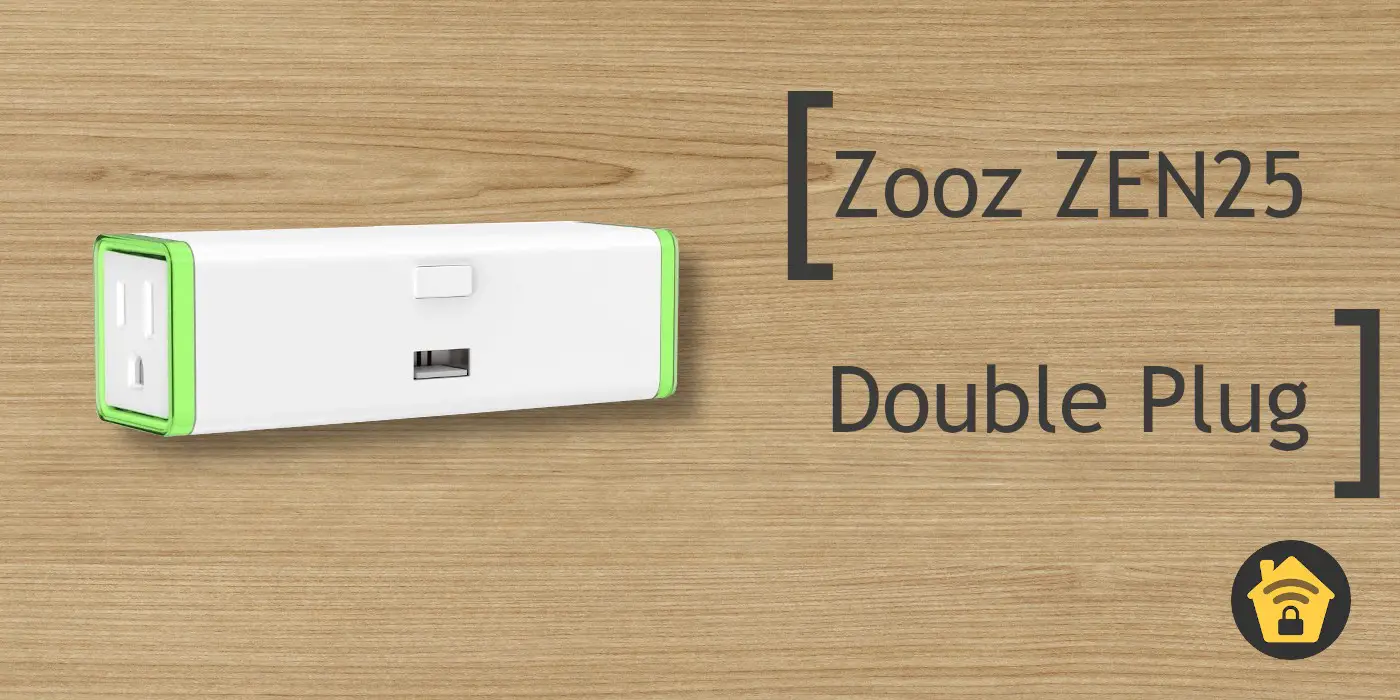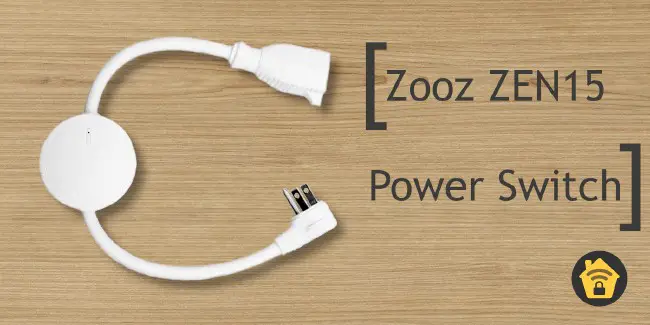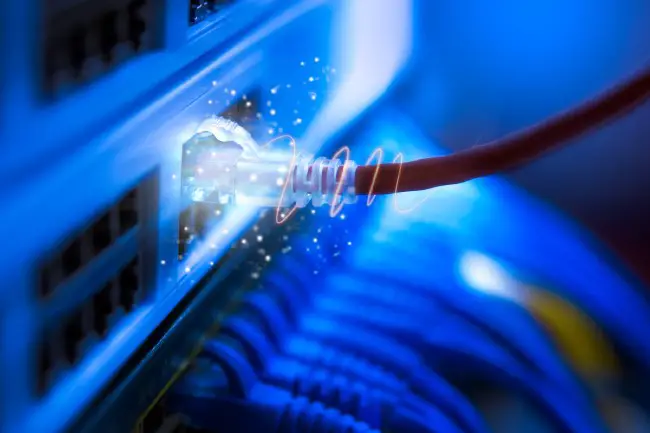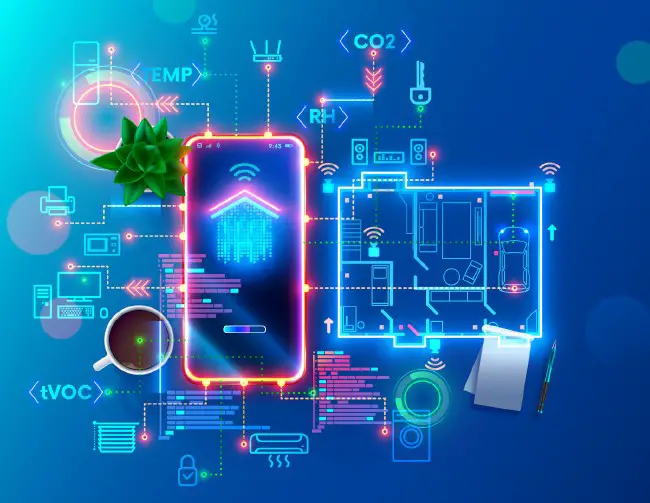Zooz ZEN25 Double Plug
The Zooz ZEN25 double plug (affiliate link) is a Z-Wave power plug that has two plugs with energy monitoring. It only uses one wall outlet without blocking the second outlet, which is very nice since that allows plugging more devices into the same wall outlet. There is a button on the front of the device which can be used to manually turn on the connected device. Press once for the left outlet and press it twice quickly to turn on the right outlet. Having a manual button is nice in case your home automation hub is down or having issues.
In addition to having two plugs, it also comes with a USB port on the front of the plug that you can use to charge a device such as a phone. However, the USB port cannot be used to turn on/off devices that are plugged into the port. There is also no energy monitoring on the USB port. The port is mostly designed to charge or power USB devices that you are not using for automation. With that said, you can receive a notification when the USB status is on or off which may be useful if you want to send a notification when a device is finished charging.
The double plug acts as a Z-Wave repeater as do many devices which have constant power. That means the plug can help strengthen the connections for other Z-Wave devices that are nearby. Other devices can connect to the repeater rather than directly to the hub when they are too far out of range.
Pros and Cons
Below are my pros and cons lists for the Zooz ZEN25 double plug:
Pros
- Includes two plugs that are individually controlled instead of one plug
- Plug does not block the second wall outlet
- Energy monitoring for both plugs
- Price (considering it includes two plugs and energy monitoring)
- Build quality seems nice
- Functions as a Z-Wave signal repeater
- Supports S2 encryption
Cons
- Does not support appliances that use larger amounts of electricity
- The USB port cannot be used for automation for USB powered devices
- The USB port does not track energy usage
- More expensive than plugs that do not have energy monitoring
- Bulkier than other single outlet plugs (but does not cover the second outlet)
Z-Wave Network Inclusion (Manual)/Exclusion Process
Inclusion: Put your home automation hub into inclusion mode. Click the button on the front of the double plug 3 times quickly.
Exclusion: Put your home automation hub into exclusion mode. Click the button on the front of the double plug 3 times quickly.
Factory Reset
If you need to reset to factory defaults for whatever reason, you can click the front button 3 times but on the 3rd press, hold it for at least 10 seconds.
Useful Z-Wave Configuration Settings
Configuration settings that you may wish to tweak are listed below. A full list of configuration parameters is available on Zooz’s website.
Parameter 1 - On/Off After Power
The default behavior is to restore to previous state so if the power was on during a power failure, it will turn back on when the power is restored. Otherwise, the power will stay off. You can also set to always stay on or off after a power failure.
Parameter 2 - Wattage Threshold
The wattage threshold is the minimum wattage necessary to send a power report. The default value is 5 Watts so if you are using less than that, you may want to lower the value so that you can monitor the energy levels below 5 Watts. Also a report will be sent if the power wattage drops 5 Watts compared to the previous power report. Enter 0 to disable reporting. Valid values are 0-65535 Watts.
Parameter 3 - Wattage Frequency
The default value for the wattage frequency is 30 seconds, but you can set it for shorter or longer periods of time. It is not recommended to set the period of time too frequent especially as the number of Z-Wave devices you have grows. Enter 0 to disable reporting. Valid values are 30-2678400 seconds.
Parameter 4 - Energy Frequency
The energy frequency is set to 5 minutes (300 seconds) by default, but you can set a more or less frequent amount of time. Since this Zooz plug is not battery powered, you could have the reports sent on a more frequent basis than 5 minutes unless perhaps you have a lot of devices that are reporting information. Enter 0 to disable reporting. Valid values are 30-2678400 seconds.
Parameter 5 - Voltage Frequency
The voltage frequency is set to 5 minutes (300 seconds) by default, but you can set a more or less frequent amount of time. Since this Zooz plug is not battery powered, you could have the reports sent on a more frequent basis. Enter 0 to disable reporting. Valid values are 30-2678400 seconds.
Parameter 6 - Current Frequency
The current frequency is set to 5 minutes (300 seconds) by default, but you can set a more or less frequent amount of time. Since this Zooz plug is not battery powered, you could have the reports sent on a more frequent basis. Enter 0 to disable reporting. Valid values are 30-2678400 seconds.
Parameter 16 - Manual Control
Manual control is enabled by default but you may disable the manual on/off button on the power plug so that you can only control the on/off states from the Z-Wave hub. If something happens to your hub, you will not be able to turn on/off devices manually unless the issues with the hub are resolved or you factory reset your device.
Parameter 17 - LED Mode
The LED mode can be set to turn off the LED indicator, to show the power consumption using various colors, or only show momentarily when the device is first turned on.
Related Posts
Zooz ZEN15 Power Switch
The Zooz ZEN15 power switch (affiliate link) is one of the few Z-Wave power plugs on the market that supports heavier duty appliances (under 15A).
Read morePower Smart Home Sensors with Power over Ethernet (PoE)
Many smart home sensors are battery powered or USB powered. Battery powered sensors are convenient when you do not have a nearby power source.
Read moreSet up Z-Wave in Home Assistant
Once you have a fresh Home Assistant installation up and running, you will likely want to dive into configuring your smart home devices.
Read more


